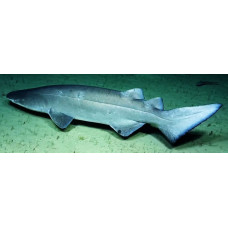Latin name
Echinorhinus cookei
Other names
Echinorhinus cookei
Identification
They have a flabby, cylindrical body (adultsharks are much more massive than juveniles) and a short, slightly flattened head. The nostrils are wide apart and framed by small skin folds. The third eyelid is missing. Behind the eyes there are tiny sprinkler. There are short furrows at the corners of the wide, curved mouth. There are 21-25 teeth on the upper jaw and 20-27 teeth on the lower jaw. The teeth are dagger-shaped with a small central point and up to 3 lateral teeth on the sides. Juvenile sharks lack the lateral denticles.
These sharks have five pairs of gill slits, the fifth pair being the longest. The lateral line has a prominent groove. The caudal peduncle is thick and the precaudal notches are absent. The caudal fin is asymmetrical, the lower lobe is poorly developed. There is a ventral notch at the tip of the upper lobe. The skin of the fish is covered with non-overlapping placoid scales, up to 0.4 cm in diameter, with a barb-like shape. They are covered with protuberances that diverge from the centre. Unlike Echinorhinus, prickly shark scales are never fused. In adults, the underside of the snout is covered with thin scales.
Features of fish fins
The pectoral fins are short, while the pelvic fins are broad with a long base. The dorsal fins are small, almost equal in size. The base of the first dorsal fin is at the base of the pelvic fins. The anal fin is absent.
Fish colouring
The colouration is plain brown or grey, the fins have a pale edge. The belly is paler.
Distribution
Found in the Pacific off Japan, Taiwan, Victoria and Queensland (Australia), and off the islands of Palau, New Caledonia, Tonga, Hawaii and possibly Gilbert. They are common from Oregon to El Salvador, including the Gulf of California, around the Cocos and Galapagos Islands, off the coast of Peru and Chile. It is a fairly rare species except in Monterey Bay, where both males and females are abundant throughout the year.
Habitat
They prefer a temperature range of 5.5-11°C. Therefore, especially in the tropics, they are hang on depths of 100-200m. There are records of these sharks being found at depths of 650 m and probably 1500 m. On the other hand, in higher latitudes they enter shallow waters, for example, in the Monterey Canyon they are regularly found at depths of 15-35 m, and one individual was caught at a depth of only 4 m. These bottom sharks inhabit continental and island shelves and the continental slope. They prefer muddy or sandy bottoms. They tolerate low oxygen levels and inhabit submarine basins where conditions are unacceptable for most sharks.
Size
The maximum recorded length is 4 m and the mass is 266 kg (female is 3.1 m long).
Behavior
Prickly sharks are rather slow, often hovering over the bottom. They make daily vertical migrations. During the day they rest in a special shelter on the seabed, at dusk they become active and move towards the shore and upwards. These migrations are associated with the hunting of gregarious fish. They are sedentary and rarely leave their restricted territory, which does not exceed 2.2 km². In Monterey Canyon they regularly congregate in groups of up to 30 individuals.
Food and feeding habits
The size and structure of sharks' mouths and throats suggest that they suck in their prey. Their diet consists of a variety of benthic and pelagic bony fish, including merlins, flatfish, sea bass, Atherinops, mackerel and herring, as well as cartilaginous fish such as chimaeras, shortfin spiny sharks, juvenile sixgill sharks and egg capsules of blacktip catsharks. These sharks also prey on octopus and squid, including Dosidicus gigasruen. In turn, juveniles of these sharks can become prey for the Bluntnose Sixgill Shark, but adults have virtually no predators in the natural environment.
Reproduction
This species reproduces by oviparity, with the embryos feeding on the yolk. So far only one pregnant female has been caught with 114 embryos, the largest litter ever seen in sharks. The newborns are thought to be around 40cm long. The age of sexual maturity is unknown; males are thought to mature at around 2m and females at 2.5-3.8m.
Fishing
Occasionally caught as bycatch in commercial bottom trawls, gillnets and longlines. These sharks are of no commercial value as their meat is soft and inedible.
Relationship with a person
Do not show aggression, if people approach them they will swim away immediately.
| Classification | |
| Phylum | Chordata |
| Class | Chondrichthyes |
| Squad | Squaliformes |
| Family | Echinorhinidae |
| Genus | Echinorhinus |
| Species | E. cookei |
| Features | |
| Conservation status | Data Deficient |
| Habitat | Bottom |
| Life span, years | No information |
| Maximum body weight, kg | 266 |
| Maximum length, cm | 400 |
| Sailing speed, m/s | No information |
| Threat to people | Not edible |
| Way of eating | Predator |
Prickly shark
Tags: prickly shark



